The beginner's guide to Google Trends
Now a well establised tool for marketers, a great deal of confusion still surrounds Google Trends, which prevents it from being fully used as a powerful marketing tool for businesses.

This guide explains some of the concepts and some tips on how to use it effectively.
What is Google Trends?
Trends shows the relative popularity of search topics in Google. This means that the interface doesn’t give you an indication of search volume, although that may correspond with an increase in search traffic for a popular term. What it shows is the relative popularity of that term in comparison with all searches for that area and date range.
- Google makes a selection of popular search terms. Highly specific queries with low volume are given a 0 rating, everything else is scaled on a 1-100 scale, depending on its popularity in relation to all other searches
- Google’s sampling will include data that may have been removed from other search products (such as related searches or autocomplete). Google says it tries to filter out attempts to manipulate or spam the interface, but mentions this might still appear if it becomes popular enough
- The data includes real-time information as well as historic data for previous years. This enables you to examine topical trends as well as recurring seasonal ones, or examine the popularity of a topic over time
In a nutshell, Trends will not provide information on every search made; the scope is too vast for that. It can, however, provide a mine of information that is relevant to your business and customer base.
Getting the right region
When you first access Trends, it generally shows you data for the US. So, the first step is to ensure that you are looking at search information that is relevant to your location, which you can change at the top.
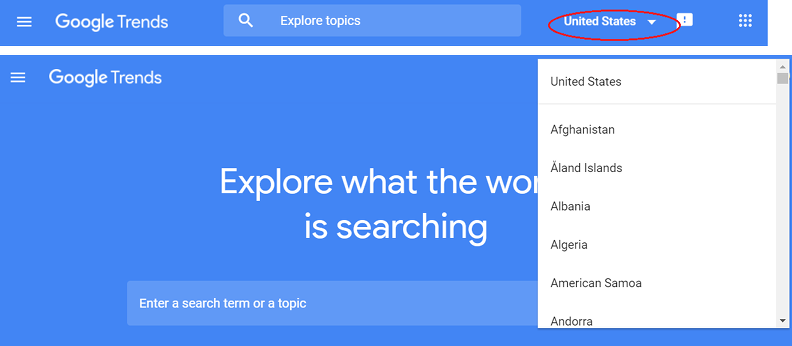
Although it is possible that search trends may be similar across different countries, it’s usually best to isolate the target region you are interested in. You can always use a filter comparison feature to check the popularity between different countries later.
Keyword or entity?
When you start to enter a term you wish to search for, Google will make some suggestions. At the top of the list will be the selected terms as a general search query. It will also suggest entities that it has noticed in connection with the keywords. This means you can explore the popularity of entire topics, working from the top-down instead of starting from the individual keywords and working upwards.
Entities can cover a number of things. They can include topic-related items (things that share the same concept), specific brands or things that match the query, or even actions. For example:


- "Business" as a query allows me to select results that Google has tagged with organisation markup (from embedded schema and Google My Business data). It also gives me the opportunity to examine the popularity of business searches on Google Maps (unsurprisingly, the number of people requiring Google Map directions to businesses has dropped significantly after the UK lockdown), and notes the related topic of 'Job'
- When using a general phrase such as 'virus', Trends offers the possibility of narrowing this to a computer or biological virus, as well as narrowing down to the virus of current topical notoriety
When looking at entities, it’s likely Google will have more interesting data to offer, as these have been noted as identifiable search topics. If you use search terms, there will be no ranking if it is not deemed a popular search. However, although you can compare search terms and topics on the graph, the two areas are measured differently (so be careful with your subsequent analysis). Topics will include terms that have a similar concept, whereas searches will be more of a general match to the query string.
If you wish to narrow the focus of a keyword search, you can use the following operators:
| Search term | Type of results you can see |
| tennis shoes | Results can include searches containing both tennis and shoes in any order. Results can also include searches like "red tennis shoes," "funny shoes for tennis," or "tennis without shoes." No misspellings, spelling variations, synonyms, plural, or singular versions of your terms are included. |
| "tennis shoes" | Results include the exact phrase inside double quotation marks, possibly with words before or after, like "red tennis shoes." |
| tennis + squash | Results can include searches containing the words "tennis" OR "squash." |
| tennis -shoes | Results include searches containing the word "tennis," but exclude searches with the word "shoes." |
| center + centre + centere | Results include alternative spellings like “centre” or “centere,” and common misspellings like "centere." Trends considers each version of a word a different search, including misspellings. |
You can then, in one of the world’s most annoying interfaces, add in additional terms and topics to compare, or edit and remove an existing search term:

(Here we can see that 'customer service' becomes a very popular term between 12 noon and 2 PM every day except Sunday, which is usually when most employees are having a lunch break themselves).
Using filters
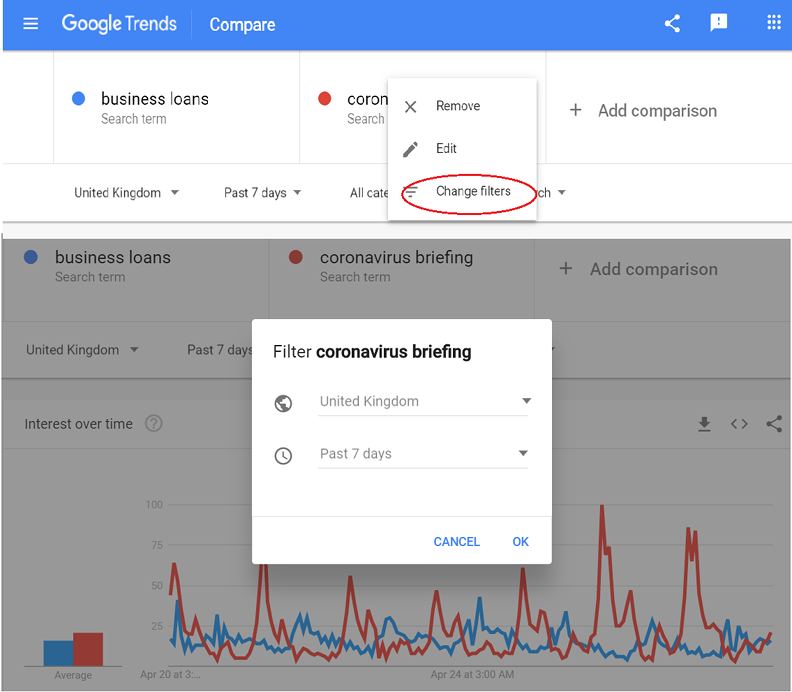
If all this wasn’t fun enough, Trends also offers filtering options so you can further refine the data:
Date range
This allows you to change the period in which the term is examined. This can let you examine long-term trends to see if terms or topics are gaining or losing popularity, or even real-time data in the last few hours, to surface hyper-topical interest such as the time of day a query is most popular
For example, until the beginning of March, “social distancing” wasn’t really a thing anyone searched for, but people are getting used to it now:
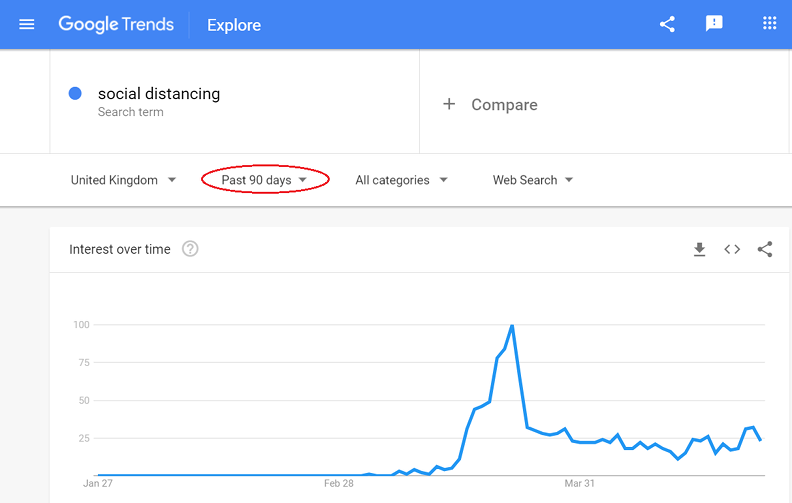
Similarly, a high profile individual advocating uses of disinfectant not recommended by the manufacturer has also prompted a surge of interest:
It’s no surprise that online meeting platforms are all hot topics, but which one is getting the most popularity at the moment?
(note how MS Teams is more popular during the working week than weekends, reflecting its likely usage). Everyone published their “how to use Zoom effectively” guide yet?
- The date range allows you check that a topic or term does not have declining visibility, and allows savvy marketers to identify regular and predictable surges of popularity with which to coordinate campaign activity.
- Regular surges of popularity for queries can also indicate content gaps where creating useful material might harvest regular interest and traffic from an audience. Be careful, however, of creating content for 'spikes' – topics that surge then die off completely. It’s likely that interest in that term will have passed before the content is ready and indexed on the web
Categories
This lets you specify a topical category, so if your chosen term has multiple meanings, you can help isolate the correct context which will make the analysis more accurate. Note that this might help refine results where this isn’t automatically suggested by Google when you enter your key terms.
- This can be particularly useful for brand terms when there is potential ambiguity with non-brand queries, or brands in different sectors
- This can also highlight topics of popularity within certain topic sectors. For example, the term 'online meetings' hasn’t changed popularity in the UK business sector for the last 90 days, but changing the category to 'health' shows a different picture:

Drilling into this further shows that important counselling meetings (AA, NA) are related to this, as these can no longer be safely carried out in groups
Search results
This allows you to refine the type of search results to compare popularity. By default, this is set to 'web search' which will cover everything, but you can also specify particular types of Google search products too: images, news and YouTube searches.
It is worth checking the popularity of topics that have relevant search result platforms. For example, the cancellation of the early season races abruptly halted the seasonal uplift of general websearch for Formula 1 keywords.
However, when looking at YouTube (where fans can get their fill of highlights from years past or the replacement Esports events), the trend has maintained its upward trajectory:
Data comparison
If you wish to compare data from different regions (comparing different time periods can cause issues), then click on the three dots to edit the search term, and choose 'change filters'.

This lets you compare trend data between different countries, or against a global average (worldwide) to see if trends in a region are unusual.
Other features
The main feature set relies on users knowing what questions to ask (search terms, topics, etc). However, Trends also has a section which will show related topics, which may surface topics and queries that were not immediately obvious with the first query.
Top and rising terms
For each keyword or topic, Trends will show a small panel listing the top and rising searches related to that query, as well as a regional breakdown.
As mentioned earlier, Google samples a range of searches from the millions it receives, and will display the ones most commonly associated with the query. Top searches are those that are most frequently associated with the term in the location and timeframe that have been selected.
Clicking the drop-down will toggle between ‘top’ and ‘rising’ searches. Rising searches are those that have shown an increase in popularity during the timeframe selected, compared to the previous period.
Terms listed as ‘breakout’ have shown a 5,000% increase (or greater), and so might be useful topics to consider in terms of emerging trends.
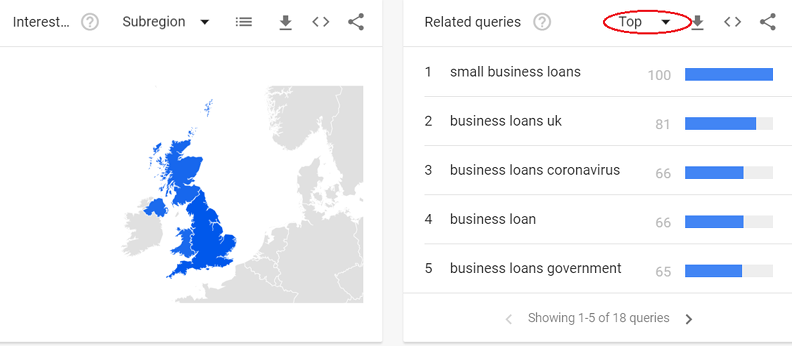
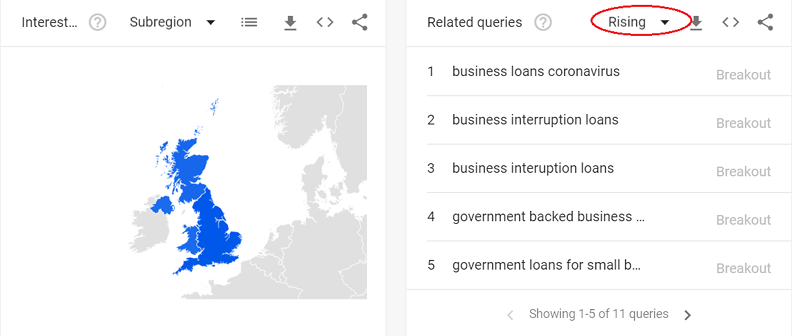
- In some cases, top and rising terms may be similar or identical. However, in this case we can see that 'business interruption...' is a growing search topic related to business loans, including loans during the coronavirus lockdown period. Also popular are loans for small businesses, and loans that are backed by the government (as opposed to high street or other lenders, presumably). This enables companies to hone in on the actual search language being used by their potential customers. Even if popular search intent did not match with a product or service, there is the potential for a useful blog article that provided this information (and therefore helping to increase brand awareness)
- This is where using the category filter can help eliminate ambiguous terms that are irrelevant
- The display section only displays the first few terms, but the complete list of top and rising terms can be downloaded by clicking on the arrow link
- Likewise, regional data can be toggled between subregions and cities to isolate particular areas where search popularity is growing. Again, the full list can be downloaded for greater detail (as the map can often be obscured with cluster points
Tips and tricks
Some general techniques to get useful data from Google Trends.
Compare and contrast
It's tempting to take the first view at face-value, but this can often be misleading. Instead, check different views of the same topic to ensure you've got the right context and understanding.
For example, looking at the last 30 days might give a totally different impression to a 12 month view such as a downward trend that doesn't show the huge increase that happened just before your chosen date range.
Think about people first and keywords second
While Trends is a useful place to check those high volume keywords, the most useful insights come from thinking about the people you are trying to reach. Focusing first on what people are trying to achieve in search engines can lead you to realisations and ideas in completely unexpected areas. Looking at things from a customer's perspective - their daily routines, the challenges and problems they face - could unlock entirely new ideas and understanding about how you can help them and prove useful.
Brand awareness
Enter your brand to check that popularity is not waning, or being confused with non-relevant ambiguous searches (this is something that third party keyword monitoring tools may not be able to differentiate).
Brand searches tend to locate pages from the brand domain, so are 'easy click' traffic.
Appearing as a recognised entity shows the Google is aware of the brand and likely to return it for searches it thinks are relevant.
Declining brand popularity may reflect a loss of business, or increased activity from competitors in search marketing.
Know your seasonality
Very few, if any, searches maintain an upward trend over time. Look at products, services and even core pages to determine if there are regular peaks in interest, then coincide marketing to arrive before or during that peak.
This can often be surprising. Looking at the UK in the last 5 years, when are 'gin cocktails' searched most frequently? Not during the hot, sunny, summer months, but during the Christmas to New Year period, although there has been a similar surge in April this year to Christmas 2019.
This would imply that gin cocktail popularity is more closely related to social activity and spare time (holidays, home furloughs and Stanley Tucci) than the weather, which might influence content for a summer campaign from a drinks company.
What are the niches around known events?
Searching for a specific known event can open up content possibilities in the related topics, and top & rising search terms suggestions.
As many forthcoming events are currently postponed, queries for ticket refunds, date rescheduling and forthcoming dates for 2021 are starting to emerge.
Additionally, archive footage for previous years in YouTube results can also be seen for some queries. Providing a channel for this may keep customers engaged until more conventional services can be resumed.
Emergent and related topics
The top and rising terms can also highlight useful topical areas which do not currently have any good quality content on a website.
If fundamental to brand, this content can be worked into the main site architecture as a useful landing page. Otherwise, more peripheral topics can be dealt with on a topical platform, such as a blog post.
Some consideration must be given to what is already appearing in search results for these queries. For rising search topics, there may not be a great deal of depth in search results (providing an opportunity). Otherwise, an enterprising site may have already been identified as an authority source on the subject by offering a good content page that has quality and expertise.
For example: the coronavirus outbreak saw a massive spike in searches from diabetics, looking for authoritative advice relating to the impact on their condition. New searches emerged for Type I and Type II diabetes in conjunction with 'coronovirus' and 'covid-19', as well as general risks and mitigations (isolation and testing). Although recognised authority sources such as the NHS and registered diabetic charities and organisations chiefly surfaced for queries, there were numerous online newspaper articles.
Newspaper content articles were also more prevalent for terms dealing with 'self isolation'. This showed rising terms indicating specific types of people (carers, elderly, NHS staff) as well as those with particular conditions (diabetes, high blood pressure, depression). Related topics also indicated popular searches for exercise, mental health and pay during self-isolation, which were all being addressed through short-form article content from newspapers at the time, and not through authority sites or specialised service websites.
Regionality
Search topic popularity can be checked with regional interest to provide a hyper-local content strategy, or to double check paid search is being correctly targeted.
Bid weighting can be applied to areas where the target term is popular and likely to attract volume.
Broader search terms can be applied to areas where the term is popular (and will likely drive other related terms that are of interest).
Website content can be created and targeted at those regions, if relevant. If a site provides products or services for a particular service area, use Trends to see what are regular and important search topics for areas covered by the service, and ensure that content is included on site pages.
Check keyword seed lists
There are lots of keyword tools that generate scores of keyword suggestions based on these appearing...at some time...on a related search in Google. Most will be sorted based on estimated volume, which for non-paid interfaces relies on highly abstracted figures provided by Google (or for some tools, their in-house benchmark).
Running these through Google Trends and filtering by category or region, can help illustrate seasonal periods of interest for terms that may not have initially been considered, and further trigger avenues of content creation using the related 'rising' and 'top' terms.
Further reading
Do you have a challenge we can help with?
Let's have a chat about it! Call us on 01903 337 580